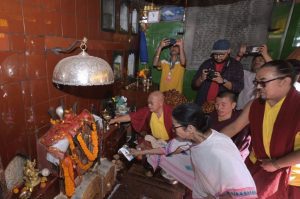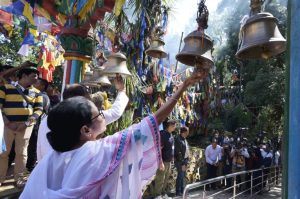West Bengal Mahakaal Temple in Siliguri: In a major announcement combining faith, culture, and tourism development, West Bengal Chief Minister Mamata Banerjee unveiled plans to build a grand Mahakaal Temple complex in Siliguri, designed to become one of the most significant spiritual landmarks in North Bengal. The announcement marks a new chapter in the state’s cultural rejuvenation and tourism infrastructure expansion, with the Chief Minister emphasizing the need to preserve Bengal’s religious heritage while promoting inclusive regional growth.

The new Mahakaal Temple project, to be modeled on the spiritual aura of Ujjain’s Mahakaleshwar Jyotirlinga, is envisioned as a blend of traditional Hindu temple architecture and modern amenities. It will be situated near the foothills of the Himalayas, overlooking the serene landscapes of Siliguri — a strategic location that connects the plains of Bengal to the hills of Darjeeling and Sikkim.
A Vision Rooted in Faith and Development
Chief Minister Mamata Banerjee announced the project during her recent visit to North Bengal, where she attended a series of administrative meetings and reviewed ongoing infrastructure works. During her address, Banerjee said,
“Siliguri holds a special place in Bengal’s heart. It is not just a gateway to the hills, but a melting pot of faith, trade, and culture. The Mahakaal Temple will symbolize unity in diversity and our deep spiritual roots.”
The announcement was greeted with enthusiasm by locals, devotees, and tourism entrepreneurs, who see the proposed temple as a catalyst for transforming Siliguri into a major pilgrimage and tourism hub.
Architectural Inspiration and Cultural Significance
Preliminary designs shared by the West Bengal Tourism Department indicate that the Mahakaal Temple will be built using stone masonry and traditional Bengal temple art, incorporating elements of Nagara-style architecture found in classical Hindu temples. The temple complex is expected to feature:
- A main sanctum housing the Mahakaal deity, symbolizing Lord Shiva as the eternal cosmic energy.
- Meditation and spiritual centers for devotees and pilgrims.
- Water bodies, gardens, and heritage pathways, inspired by ancient temple layouts.
- Public amenities such as rest houses, parking, and interpretation centers for visitors.
The design aims to balance religious aesthetics with environmental sustainability, using eco-friendly materials and local craftsmanship.
Boost to Religious and Eco-Tourism in North Bengal
Siliguri’s growing connectivity — with Bagdogra Airport, New Jalpaiguri railway station, and expanding highways — has made it an emerging center for tourism and trade. The Mahakaal Temple project aligns with the state’s broader goal of positioning North Bengal as a multi-dimensional tourism destination, encompassing spirituality, adventure, and ecology.
Tourism officials suggest that the temple will attract not only Hindu devotees from across India but also visitors from neighboring countries such as Nepal, Bhutan, and Bangladesh, given Siliguri’s cross-border accessibility. The temple complex could potentially create hundreds of jobs in construction, hospitality, and transport sectors, reinforcing local economies.
Mamata Banerjee’s Spiritual Development Vision
The Chief Minister’s announcement of the Mahakaal Temple is part of a broader series of spiritual and cultural projects initiated across the state, reflecting her government’s focus on preserving Bengal’s diverse faith traditions.


Recent years have seen the revitalization of the Tarakeswar Temple, enhancement of infrastructure around Dakshineswar, and restoration of Adyapeath Mandir and Kalighat Temple in Kolkata. These initiatives not only honor Bengal’s religious legacy but also integrate cultural tourism with economic opportunity.
According to senior officials in the West Bengal Tourism Development Corporation (WBTDC), the upcoming Mahakaal Temple will serve as a “spiritual anchor” for Siliguri, comparable to how Dakshineswar and Kalighat define Kolkata’s sacred geography.
Local Sentiment: Pride and Anticipation
Residents of Siliguri and surrounding areas have welcomed the Chief Minister’s announcement with visible excitement. Many believe the project will enhance the city’s identity beyond being a trade and transit hub.
Local resident and shopkeeper Rajesh Agarwal said,
“This is a proud moment for Siliguri. A temple like Mahakaal will bring peace, prosperity, and pilgrims. It will also give our youth new job opportunities.”
Cultural activists in North Bengal also see the project as a chance to highlight the region’s inclusive spiritual heritage, where Hindu, Buddhist, and tribal traditions have coexisted for centuries.
West Bengal Mahakaal Temple in Siliguri: Infrastructure and Planning Highlights
Preliminary plans indicate that the Public Works Department (PWD), in collaboration with the Tourism and Urban Development Departments, will oversee the temple’s construction. Key highlights include:
- Land acquisition and site development in coordination with local municipalities.
- Architectural design by renowned temple architects familiar with traditional Indian craftsmanship.
- Sustainable landscaping, including water harvesting, solar energy use, and tree preservation.
- Connectivity enhancement, with improved access roads and public transport links to the site.
Experts believe that once operational, the Mahakaal Temple complex will complement the region’s existing attractions — such as Coronation Bridge, Mahananda Wildlife Sanctuary, and Kalimpong monasteries — to create an integrated cultural circuit.
Balancing Faith with Conservation
Environmental experts have advised that the temple project be implemented with a focus on sustainability, given the ecological sensitivity of the Himalayan foothills. The West Bengal Pollution Control Board (WBPCB) is expected to assess the environmental impact before construction begins.
Dr. Debashis Sarkar, an environmental planner from the University of North Bengal, commented,
“A project of this scale must respect local biodiversity and water systems. With proper planning, the Mahakaal Temple can become a model for eco-conscious religious infrastructure.”
Political and Social Dimensions
The announcement also carries political undertones, with observers interpreting it as a gesture of cultural inclusivity by the Trinamool Congress government. Banerjee, known for balancing secular governance with respect for all religions, reiterated that her administration “celebrates every faith equally.”
Political analysts note that the temple project may strengthen the TMC’s influence in North Bengal, where the party has been seeking to consolidate its grassroots support. However, opposition parties have raised questions about the project’s cost and execution timelines.
A senior BJP leader from Siliguri stated anonymously that while the project is “culturally commendable,” the government must ensure “transparency in funding and timely delivery.”
Cultural Heritage and Symbolism of Mahakaal
The concept of Mahakaal — one of Lord Shiva’s most revered forms — symbolizes eternal time and cosmic dissolution, representing the cycle of life and death. Building a temple in his honor in Siliguri carries profound cultural meaning for devotees in Bengal and beyond.
Historians note that the name “Mahakaal” appears in Puranic texts and has deep connections with the spiritual geography of India. Replicating such symbolism in North Bengal helps reinforce cultural continuity while creating a new pilgrimage site in eastern India.
Integration with the Bengal Tourism Circuit
The state government aims to integrate the Siliguri Mahakaal Temple into an expanded “Spiritual Bengal Circuit”, linking sites such as:
- Tarapith (Birbhum) – dedicated to Goddess Tara
- Dakshineswar Kali Temple (Kolkata)
- Kalighat Temple (Kolkata)
- Tarakeswar and Boral Shiv Temples (Hooghly)


Such initiatives align with India’s Dekho Apna Desh campaign by the Ministry of Tourism, encouraging domestic travel and cultural exploration.
Economic and Employment Prospects
Economists estimate that the temple project could generate significant economic multipliers through:
- Local employment in construction and services
- Growth in handicrafts and souvenir markets
- Expansion of hotels and transport infrastructure
- Cultural events, festivals, and pilgrimage tourism
The Siliguri Chamber of Commerce has welcomed the move, calling it a “landmark opportunity” for the city to diversify its economy beyond logistics and trade.
Future Outlook: A Temple for Generations
The Mahakaal Temple in Siliguri is expected to stand as a symbol of Bengal’s spiritual unity and cultural pride — a destination where devotion meets design, and tradition harmonizes with progress.
For Mamata Banerjee, the project reaffirms her long-held message that “faith and development are not contradictory but complementary forces.”
If executed with transparency, sensitivity, and sustainability, the Mahakaal Temple could emerge as one of India’s most iconic modern pilgrimage sites, transforming Siliguri into a spiritual gateway to the Himalayas.
External Resources
- West Bengal Tourism Department – Official Site
- Ministry of Tourism, Government of India
- Incredible India – Spiritual Circuits
- West Bengal Pollution Control Board
Also read: Home | Channel 6 Network – Latest News, Breaking Updates: Politics, Business, Tech & More

